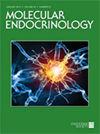Estrogen, SNP-Dependent Chemokine Expression and Selective Estrogen Receptor Modulator Regulation.
Q Biochemistry, Genetics and Molecular Biology
引用次数: 25
Abstract
We previously reported, on the basis of a genome-wide association study for aromatase inhibitor-induced musculoskeletal symptoms, that single-nucleotide polymorphisms (SNPs) near the T-cell leukemia/lymphoma 1A (TCL1A) gene were associated with aromatase inhibitor-induced musculoskeletal pain and with estradiol (E2)-induced TCL1A expression. Furthermore, variation in TCL1A expression influenced the downstream expression of proinflammatory cytokines and cytokine receptors. Specifically, the top hit genome-wide association study SNP, rs11849538, created a functional estrogen response element (ERE) that displayed estrogen receptor (ER) binding and increased E2 induction of TCL1A expression only for the variant SNP genotype. In the present study, we pursued mechanisms underlying the E2-SNP-dependent regulation of TCL1A expression and, in parallel, our subsequent observations that SNPs at a distance from EREs can regulate ERα binding and that ER antagonists can reverse phenotypes associated with those SNPs. Specifically, we performed a series of functional genomic studies using a large panel of lymphoblastoid cell lines with dense genomic data that demonstrated that TCL1A SNPs at a distance from EREs can modulate ERα binding and expression of TCL1A as well as the expression of downstream immune mediators. Furthermore, 4-hydroxytamoxifen or fulvestrant could reverse these SNP-genotype effects. Similar results were found for SNPs in the IL17A cytokine and CCR6 chemokine receptor genes. These observations greatly expand our previous results and support the existence of a novel molecular mechanism that contributes to the complex interplay between estrogens and immune systems. They also raise the possibility of the pharmacological manipulation of the expression of proinflammatory cytokines and chemokines in a SNP genotype-dependent fashion.雌激素,snp依赖性趋化因子表达和选择性雌激素受体调节剂调控。
我们之前报道,基于芳香化酶抑制剂诱导的肌肉骨骼症状的全基因组关联研究,t细胞白血病/淋巴瘤1A (TCL1A)基因附近的单核苷酸多态性(snp)与芳香化酶抑制剂诱导的肌肉骨骼疼痛和雌二醇(E2)诱导的TCL1A表达相关。此外,TCL1A表达的变化影响下游促炎细胞因子和细胞因子受体的表达。具体来说,最受欢迎的全基因组关联研究SNP rs11849538创建了一个功能性雌激素反应元件(ERE),该元件仅在变异SNP基因型中显示雌激素受体(ER)结合并增加E2诱导TCL1A表达。在本研究中,我们探索了e2 - snp依赖性TCL1A表达调控的机制,同时,我们随后的观察结果表明,与EREs距离较远的snp可以调节ERα结合,ER拮抗剂可以逆转与这些snp相关的表型。具体来说,我们使用大量淋巴母细胞样细胞系进行了一系列功能基因组研究,这些研究具有密集的基因组数据,证明了距离EREs较远的TCL1A snp可以调节ERα结合和TCL1A的表达以及下游免疫介质的表达。此外,4-羟他莫昔芬或氟维司汀可以逆转这些snp基因型效应。在IL17A细胞因子和CCR6趋化因子受体基因中也发现了类似的结果。这些观察结果极大地扩展了我们之前的结果,并支持存在一种新的分子机制,有助于雌激素和免疫系统之间复杂的相互作用。他们还提出了以SNP基因型依赖的方式对促炎细胞因子和趋化因子表达进行药理学操纵的可能性。
本文章由计算机程序翻译,如有差异,请以英文原文为准。
求助全文
约1分钟内获得全文
求助全文
来源期刊

Molecular endocrinology
医学-内分泌学与代谢
CiteScore
3.49
自引率
0.00%
发文量
0
审稿时长
12 months
期刊介绍:
Molecular Endocrinology provides a forum for papers devoted to describing molecular mechanisms by which hormones and related compounds regulate function. It has quickly achieved a reputation as a high visibility journal with very rapid communication of cutting edge science: the average turnaround time is 28 days from manuscript receipt to first decision, and accepted manuscripts are published online within a week through Rapid Electronic Publication. In the 2008 Journal Citation Report, Molecular Endocrinology is ranked 16th out of 93 journals in the Endocrinology and Metabolism category, with an Impact Factor of 5.389.
 求助内容:
求助内容: 应助结果提醒方式:
应助结果提醒方式:


